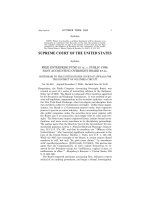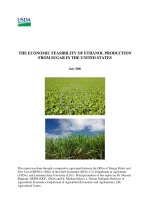FAQs Tuberculosis Component of the Technical Instructions (TIs) for the Medical Examination of Aliens in the United States doc
Bạn đang xem bản rút gọn của tài liệu. Xem và tải ngay bản đầy đủ của tài liệu tại đây (81.83 KB, 8 trang )
FAQs
Tuberculosis Component of the
Technical Instructions (TIs) for the
Medical Examination of Aliens in the United States
These questions and answers are provided for easy reference by
civil surgeons’ offices and the Bureau of U.S. Citizenship and
Immigration Services’ offices.
1. At what age is a tuberculin skin test (TST) required?
A Mantoux TST must be performed on all applicants who are 2 years of age and
older, as well as applicants less than 2 years of age if there is evidence of
contact with a person known to have tuberculosis (TB) or other reason to
suspect (TB).
2. Are there any situations in which the TST is not required for
applicants 2 years of age or older?
There are two situations in which the TST is not required. Applicants providing
written documentation (with a health-care provider’s signature) of a TST
reaction of 5 mm or greater of induration or applicants with a history of a severe
reaction with blistering to a prior TST may be excluded from this requirement.
Applicants in these two groups must undergo a chest radiograph. A verbal
history of a positive TST reaction from the applicant is not acceptable.
If the TST is not administered for one of these two reasons, the civil surgeon
should not check the box next to “Tuberculin Skin Test” in Part 2, Section 2A
of the I-693 form. Instead, the civil surgeon should clearly state the reason for
the exception in the “Remarks” portion of Section 2A.
3. Should a TST be administered if a Bacille Calmette-Guérin (BCG)
vaccination has been given in the past?
Yes. Because many BCG-vaccinated applicants have lived in areas where TB
transmission is common, the civil surgeon must perform the TST on all
applicants, regardless of history or evidence of BCG vaccination, unless one of
the two exceptions to TST administration noted in question #2 exists.
4. How should the civil surgeon interpret the TST if the applicant has
received BCG in the past?
Because many BCG-vaccinated applicants have lived in areas of the world where
TB transmission frequently occurs, the civil surgeon should order a chest
radiograph on all such applicants with a skin test reaction of 5 mm or greater of
induration, and refer the applicant to the health department if the chest radiograph
suggests active or inactive TB disease.
5. Can a TST be administered to pregnant women?
Yes, pregnancy is not a contraindication to TST administration.
6. Can the civil surgeon accept TST results measuring less than 5mm
induration or chest radiographs (images), which are dated before the
civil surgeon examination and submitted by an outside doctor's office?
Civil surgeons must ensure that the person appearing for the medical examination
is the person who is actually applying for immigration benefits. The civil surgeon
must confirm the applicant's identity by comparing facial appearance and
signature with an official government document containing a recent photograph
and signature, such as a passport, driver’s license, or other type of identity card.
The applicant’s identity must be verified in the same manner when the
applicant is referred to another facility for a chest radiograph or laboratory
test.
7. What is the length of validity of TST and chest radiograph results
obtained by the civil surgeon?
The examination by the civil surgeon is a "snapshot" of the applicant's medical
status. Therefore, the TST and chest radiograph results must be closely related in
time to the physical examination and laboratory tests.
8. Can civil surgeons use Quantiferon (QFT-G) to detect Mycobacterium
tuberculosis infection instead of a tuberculin skin test (TST)?
No. The role of QFT-G in targeted testing has not yet been fully defined and the
test currently requires laboratory capability that is not widely available (Centers
for Disease Control and Prevention. Guidelines for Using the QuantiFERON®-
TB Gold Test for Detecting Mycobacterium tuberculosis Infection, United States.
MMWR 2005; 54[No. RR-15]:49-55.) When changes to these guidelines occur,
an update will be posted at Until
then, the TST is the required method.
9. Which applicants are required to undergo a chest radiograph?
A chest radiograph is required for all applicants who:
• Have a TST reaction of 5 mm or greater of induration.
• Are immunosuppressed, regardless of the size of induration of the TST
(even if the TST measures 0 mm). This includes those who are:
o HIV infected.
o Receiving the equivalent of 15 mg/day or more of prednisone for at least
one month.
o Have a history of organ transplant.
• Have signs or symptoms of active TB, regardless of the size of induration of
the TST
10. Are pregnant women required to undergo a chest radiograph?
Women who fall into the categories listed in question #9 are required to undergo a
chest radiograph. This requirement includes pregnant (or possibly pregnant)
women. Previously, the chest radiograph could be waived for a pregnant applicant
if she had a scar or other evidence of BCG vaccination and denied having any TB-
related symptoms. This exception is no longer permissible. If the applicant decides
to undergo a radiograph during pregnancy, the possible risks of radiation to the fetus
should be explained to her and informed consent obtained, confirmed by a signed
consent form. If she wishes, the applicant may defer the radiograph until after
delivery, but the civil surgeon cannot sign the medical examination form until
the radiograph is performed and interpreted, and treatment for Class A
pulmonary TB disease, if needed, is completed.
11. If the applicant has an abnormal chest radiograph, what should the
civil surgeon do?
All applicants with an abnormal chest radiograph suggestive of active or
inactive TB disease must be referred to the TB Control Program of the local
health department for further evaluation. Applicants with clinical signs or
symptoms suggestive of TB disease should also be referred regardless of TST
induration or chest radiograph findings.
12. What is Class A–Pulmonary TB Disease, Active, Infectious?
In Class A–Pulmonary TB, the applicant has an abnormal chest radiograph
suggestive of active TB disease (see Appendix B in the TB TIs), and one or more
sputum smears positive for acid-fast bacteria (AFB) or one or more cultures
positive for M.tuberculosis complex.
13. What is Class B1–Pulmonary TB, Active, Non-infectious?
In Class B1–Pulmonary TB, the applicant has an abnormal chest radiograph
suggestive of active TB disease (see appendix B in the TIs), plus three sputum
smears negative for AFB and three cultures negative for M. Tuberculosis
complex.
14. What is Class B1–Extrapulmonary TB, Active, Non-infectious?
In Class B1–Extrapulmonary TB, the applicant has radiographic or other evidence
of extrapulmonary TB, and no evidence of pulmonary TB disease.
15. What is Class B2–Pulmonary TB, Inactive?
In Class B2–Pulmonary TB, the applicant has an abnormal chest radiograph
suggestive of inactive TB disease (see Appendix B in TIs), and no sputum smears
or cultures are required or performed.
16. What is Class B–Latent TB Infection Needing Evaluation for
Treatment (LTBI)?
In Class B–Latent TB Infection Needing Evaluation for Treatment (LTBI), the
applicant has:
• A TST reaction of 10 mm or more of induration, and a history of recent
arrival (within the last 5 years) in the United States from a high-prevalence
country.
And
• No evidence of active TB disease.
OR
• A TST reaction of 5 mm or more of induration if the applicant is in one of
these groups:
o HIV-infected persons
o Recent contacts of TB cases
o Patients with transplanted organs
o Other immunosuppressed patients (receiving the equivalent of 15
mg/day or more of prednisone for at least one month)
And
• No evidence of active TB disease.
OR
• A TST reaction of 10 mm or more of induration if the applicant is in one of
these groups:
o Persons with clinical conditions that place them at high risk (See
Appendix C of the TB TIs)
o Injection drug users
o Residents and employees of high-risk congregate settings (e.g.,
correctional facilities, nursing homes, homeless shelters, hospitals, or
other health-care facilities)
o Mycobacteriology laboratory personnel
o Children <4 years of age, or children and adolescents exposed to adults
in high-risk categories
And
• No evidence of active TB disease.
17. Should Part 3 of Form I-693 be completed when the civil surgeon is
referring the applicant for evaluation for treatment of Latent TB
Infection (LTBI)?
The 2008 TB TIs recommend that civil surgeons refer applicants with “Class B—
Latent TB Infection Needing Evaluation for Treatment (LTBI)” to the TB Control
Program of the local health department. The referral for evaluation for treatment
of LTBI is recommended, not required. Part 3 of Form I-693 should be used only
for required referrals, therefore the civil surgeon should not complete Part 3
of
Form I-693 when making this referral. It follows that the health department is not
required to complete Part 4 of Form I-693 after evaluation for treatment of LTBI
is completed or after treatment for LTBI is completed. Please see question 18 for
related information.
18. Should the civil surgeon communicate with the TB Control Program
of the local health department about the availability of latent TB
infection (LTBI) treatment?
Yes. The civil surgeon should contact the TB Control Program of the local health
department in his or her area to ascertain local policies and procedures for treating
such applicants. In some areas, the TB Control Program may be able to provide
treatment. Some health departments TB Control Programs may lack the resources
to follow up on all people with latent infection because they are focusing their
efforts on higher-priority active TB cases and their contacts.
If the health department TB Control Program is not able to accept a referral, the
civil surgeon may ask if the TB Control Program is able to provide treatment
consultation for an applicant with LTBI. The TB Control Program may also have
arrangements with other health-care providers in the community (e.g.,
community-based health centers or managed care organizations) that may be able
to provide such treatment.
19. What is Class B– Other Chest Condition (non-TB)?
In Class B– Other Chest Condition (non-TB), the applicant has an abnormal chest
radiograph, not suggestive of TB disease, needing follow-up (see Appendix B in
TIs).
20. Who has to receive TB treatment before the civil surgeon can sign the
I-693 form?
An applicant with Class A pulmonary TB disease (either smear or culture
positive) must complete
a CDC/ATS/ IDSA recommended course of anti-TB
treatment before he or she can be medically cleared by the civil surgeon. The
minimum duration of treatment is 6 months.
When treatment has been completed and the applicant is no longer infectious, a
representative of the health department should sign the “Referral Evaluation”
section (Part 4) of the I-693 form, indicating that the applicant has complied with
the recommended health follow-up. The applicant should then return to the civil
surgeon with this form. If TB treatment has been prolonged, other portions of the
medical examination may need to be repeated. When all portions of the
examination are current the civil surgeon can sign the I-693 form.
21. Can the civil surgeon medically clear the applicant for TB even if the
applicant is going to receive treatment for latent TB Infection (LTBI)?
Yes. Referral for treatment and/or completion of treatment for LTBI is not
required for the civil surgeon to sign the I-693 form. As regards TB, the signature
indicates the applicant is free of Class A pulmonary TB disease.
22. Can the civil surgeon medically clear the applicant for TB even if the
applicant is classified as “Class B1–Extrapulmonary TB, Active, Non-
infectious”?
Yes. By definition, Class B1-Extrapulmonary TB does not involve the lungs.
Completion of treatment for Class B1-Extrapulmonary TB is not required for the
civil surgeon to sign the I-693 form. As regards the TB, the signature indicates the
applicant is free of Class A pulmonary TB disease.
23. Are there quick reference charts in the Technical Instructions that
refer to risk factors for progression of TB infection to TB disease,
TB
signs and symptoms, and TB classifications?
Yes, these charts are found in Appendix C of the TB Technical Instructions.
24. Are these 2008 Civil Surgeon Tuberculosis (TB) Technical
Instructions available on-line?
Yes, they are available at />.
25. What Technical Instructions should the civil surgeon follow for the
non-TB portions of the medical examination?
The civil surgeon should follow the 1991 Technical Instructions for Medical
Examination of Aliens in the United States for all non-TB portions of the medical
examination (other infectious diseases, mental health conditions, etc.), except for
vaccinations. For the latter, there are specific Technical Instructions to Civil
Surgeons for Vaccination Requirements. All civil surgeon Technical Instructions
are available at









